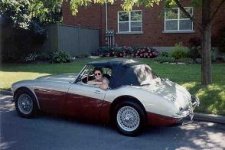davidb
Jedi Trainee
Offline
I was discussing the maximum cylinder bore on Big Healey engines the other day, with a neighbour of mine who has an MG. I seem to recall seeing rings at .060 over. What do you do after that? Any one out there have an idea what is acceptable? A lot of our cars are getting up there in mileage and many/most have been rebuilt at least once. Are liners available, as in TRs?
Just so you'll wake up screaming in the middle of the night, I should add that when I rebuilt my engine years ago, I found - get ready for this - <span style="text-decoration: underline">chunks</span> of rings in the oil pan from the previous owner's total neglect. I bought it without a compression test. Nice shiny red paint, and love at first sight.
And the thing still ran.
Cheers,
Dave
Just so you'll wake up screaming in the middle of the night, I should add that when I rebuilt my engine years ago, I found - get ready for this - <span style="text-decoration: underline">chunks</span> of rings in the oil pan from the previous owner's total neglect. I bought it without a compression test. Nice shiny red paint, and love at first sight.
And the thing still ran.
Cheers,
Dave

 Hi Guest!
Hi Guest!

 smilie in place of the real @
smilie in place of the real @
 Pretty Please - add it to our Events forum(s) and add to the calendar! >>
Pretty Please - add it to our Events forum(s) and add to the calendar! >> 




